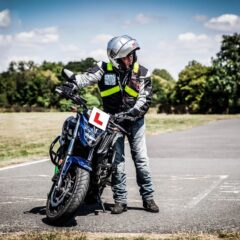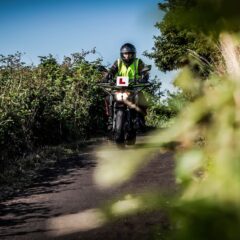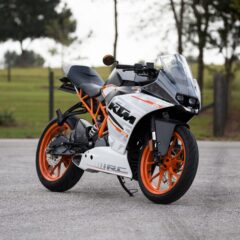
7 Top Motorcycle Accessories
With Christmas just around the corner, you might be wondering what to get your favourite motorcycle enthusiast or even a little something for yoursel...
 Phoenix Motorcycle Training LTD
Phoenix Motorcycle Training LTD
 Phoenix Motorcycle Training LTD
Phoenix Motorcycle Training LTD

So you’re thinking about entering the exhilarating world of two-wheeled freedom – learning to ride a motorcycle in the UK! Once you hear it, the call of the open road is impossible to ignore. Learning to ride a motorcycle is a journey that promises adventure, freedom, and a unique sense of connection with the road.
As you embark on the exciting journey towards a two-wheeled licence, you probably have a flurry of questions you want answered. How do I even start? What’s the secret to mastering the art of two wheels? And which motorcycle licence should I get? You’re not alone. Last year, around 60,000 riders got their full UK motorcycle licence.
We helped many of them start their journey and pass their test on the first try! From the thrill of your first ride to full licence training, helping new riders find their wheels is what makes us grin. This blog covers everything you need to know to make your motorcycle journey unforgettable. From balance to building technique, we’ve got you covered.
Learning to ride a motorcycle is very much like learning to ride a bicycle all over again, but this time, with a thrilling twist. There’s a little more power in these two wheels than your dinky balance bike!
Learning to balance on two wheels is the foundation of your motorcycling skills. If you can ride a bicycle, you’re one step ahead. Even if you can’t; you’re still in the right place. Balancing on a motorcycle is similar to a bicycle, albeit with a bit more weight and power.
To give yourself a head-start on CBT motorcycle and scooter training, spend a little practising balance. Borrowing a friend’s bike and riding in a controlled environment, like an empty parking lot, is perfect. This simple step will boost your confidence when you first throw your leg over a motorcycle or scooter.
At Phoenix Motorcycle Training, we’ve helped countless riders find their balance. We start the motorcycle licence journey getting used to the feel of a scooter or low-powered motorcycle. You’ll learn where the controls are, how to start and stop the engine, and how to balance on your machine when it’s moving slowly. That gives you more confidence when it comes to navigating the road safely.
So, you’ve got your balance down, and you’re ready to roll. Before you rush out to buy a motorcycle, you need to understand the UK motorcycle licensing process. It essentially has two parts:
The Compulsory Basic Training (CBT) is your first milestone on the road to becoming a licensed motorcycle rider. It’s a crucial step, especially if you’re a new road user. CBT provides you with the foundational skills and knowledge required for safe riding. This training builds your confidence and skill as well as ensuring you meet the legal requirements for riding on the road.
After you’ve got your CBT, you’re ready to progress toward your full motorcycle license. You should practice riding as much as possible. Between your CBT and test for a full licence, gaining on-road experience is crucial. It’ll build your confidence and skill too. Remember, practice builds muscle memory and improves your rider technique.
Our final tip is all about ensuring you not only pass your motorcycle test but also become a skilled and confident rider. As your confidence and skills grow, so will your love of riding. Although practising on your own is essential, nothing quite replaces expert guidance from trained instructors. They’ve been down the road before, quite literally, and can help you avoid common pitfalls while honing your skills.
To prepare for your motorcycle license test, it’s crucial to practice regularly – even before you book your full license training day. Building muscle memory and refining your riding technique is key to passing on your first attempt. Here are a few practice exercises to consider:
Smooth and controlled turns are both an art and a fundamental skill that will serve you well on the road. Try this exercise to improve your steering technique:
Check out our blog about motorcycle turning techniques for more exercises.
Mastering braking is essential for safety. Remaining stable as you slow down can feel harder than it looks. This exercise will improve your front brake focus:
You’ll find more motorcycle braking exercises in our blog about motorcycle braking techniques.
Maintaining control while testing your motorcycle’s power builds confidence and rider safety. Try this exercise:
You’ll find additional acceleration exercises in our blog with acceleration tips for new riders.
Now you’ve just completed your crash course on the top three tips for learning to ride a motorcycle in the UK, it’s time to think about getting your licence. You’re not alone on this journey. At Phoenix Motorcycle Training, we’re passionate about helping more riders enjoy the thrill of two-wheeled adventure. We’ve helped numerous individuals just like you start their motorcycle journey and pass their tests on the first try.
We’ll build on the skills you’ve already developed from riding with your CBT and tailor our training to your needs—from basic riding techniques to advanced manoeuvres. When it’s time to take that leap of faith and book your motorcycle training, we’ve got you covered. Our training centres are all over the UK, so your motorcycle journey can always start with us! Find a centre near you and ride into the adventure of a lifetime!

With Christmas just around the corner, you might be wondering what to get your favourite motorcycle enthusiast or even a little something for yoursel...

If you love motorcycle riding, you’ve probably daydreamed about riding a motorbike for a living. A professional racer or stunt rider is OK for some...

Getting a UK motorcycle licence can seem a complicated process. Particularly when compared to a driving licence for a car. Whether you choose the pro...
This website uses cookies to personalise content, ads, and analyse traffic, sharing data with partners who may combine it with other information. See our Privacy Policy for more information.